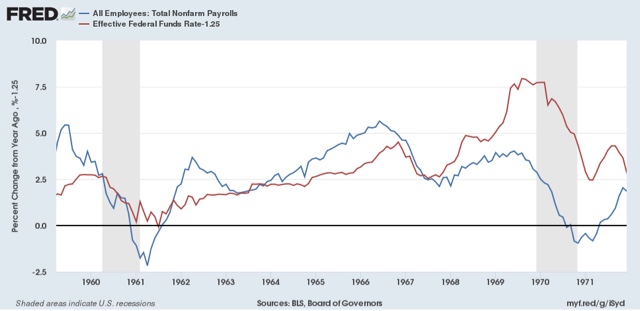Summary:
Interest rates and jobs: a variation on the model Friday is nonfarm payrolls day, so in the absence more noteworthy economic news, let me follow up on Monday’s post in which I discussed “A simple model of interest rates and the jobs market.” In it, I suggested that: 1. a YoY increase in the Fed funds rate equal to the YoY% change in job growth has in the past almost infallibly been correlated with a recession within roughly 12 months. 2. the YoY change in the Fed funds rate also does a very good job forecasting the *rate* of YoY change in payrolls 12 to 24 months out. One shortfall of that model is that there are two “false negatives” in the low interest rate environment of the 1950s, during which the YoY increases in interest rates by the Fed were
Topics:
NewDealdemocrat considers the following as important: Uncategorized
This could be interesting, too:
Interest rates and jobs: a variation on the model Friday is nonfarm payrolls day, so in the absence more noteworthy economic news, let me follow up on Monday’s post in which I discussed “A simple model of interest rates and the jobs market.” In it, I suggested that: 1. a YoY increase in the Fed funds rate equal to the YoY% change in job growth has in the past almost infallibly been correlated with a recession within roughly 12 months. 2. the YoY change in the Fed funds rate also does a very good job forecasting the *rate* of YoY change in payrolls 12 to 24 months out. One shortfall of that model is that there are two “false negatives” in the low interest rate environment of the 1950s, during which the YoY increases in interest rates by the Fed were
Topics:
NewDealdemocrat considers the following as important: Uncategorized
This could be interesting, too:
tom writes The Ukraine war and Europe’s deepening march of folly
Stavros Mavroudeas writes CfP of Marxist Macroeconomic Modelling workgroup – 18th WAPE Forum, Istanbul August 6-8, 2025
Lars Pålsson Syll writes The pretence-of-knowledge syndrome
Dean Baker writes Crypto and Donald Trump’s strategic baseball card reserve
Interest rates and jobs: a variation on the model
Friday is nonfarm payrolls day, so in the absence more noteworthy economic news, let me follow up on Monday’s post in which I discussed “A simple model of interest rates and the jobs market.”
In it, I suggested that:
1. a YoY increase in the Fed funds rate equal to the YoY% change in job growth has in the past almost infallibly been correlated with a recession within roughly 12 months.
2. the YoY change in the Fed funds rate also does a very good job forecasting the *rate* of YoY change in payrolls 12 to 24 months out.
One shortfall of that model is that there are two “false negatives” in the low interest rate environment of the 1950s, during which the YoY increases in interest rates by the Fed were relatively modest, and did not exceed the YoY change in payrolls until after the recessions had already begun.
I suspect that in a low interest rate environment, more modest increases in interest rates might have a more pronounced effect. For example, an increase in mortgage rates from 2% to 4% doubles the monthly interest payments on a mortgage (i.e., a 100% increase), whereas an increase from 8% to 10% only increase it by 25%.
While I haven’t explicitly looked at mortgage rates as of yet, what I did do is plot the simple rise in interest rates from their low points near the beginning of each expansion since the mid-1950s, and see if, during a period of Fed tightening, they always rose to exceed the YoY% change in job growth *before* the onset of all of the recessions since. Here’s what I got:
So the simplest answer is, yes they did. To be more precise, here is the number of months by which this metric led the onset of the last 8 recessions:
1957: 8 months
1960: 1 month
1970: 6 months (while payrolls decelerating) *(false positive for deep slowdown of 1966)
1973: 6 months
1980: 15 months
1982: 12 months* (interest rates never declined below YoY jobs growth)
1990: 17 months *(false positive for 1984 slowdown)
2001: 5 months *(false positive during 1994)
2008: 34 months
Note that there are 3 significant false positives that occur when there have been two interest rate cycles during an expansion. I only get resonable numbers by re-setting the low in interest rates during those cycles. And since the YoY change in payrolls is a good mid-cycle indicator, by insisting that the intersection occur while YoY payroll growth is declining, I’m already conceding that it must occur later in an expansion.
Finally, there is still the problem of 1933-55, during which time interest rates barely budged.
So unfortunately it seems that this metric is of limited value. It does have some merit as a “yellow light,” strongly cautioning that there is a heightened probability of a recession is within 18 months, with the “red light” suggesting the near certainty of a recession within 12 months only if/when the YoY increase in interest rates exceeds the (decelerating) YoY% growth in jobs. It also does seem to suggest something about the depth of the subsequent recessions, as the two “worst” values generated by the metric occur in advance of the 1982 and 2007 deep recessions.
So, where are we now? Here:
By this metric, we are on the verge of activating the “yellow light.”









